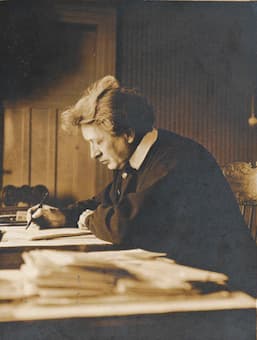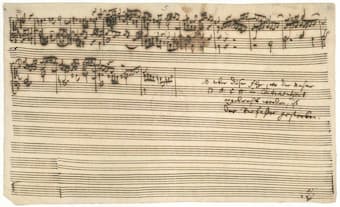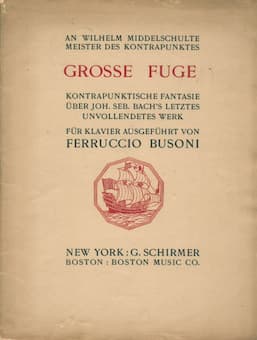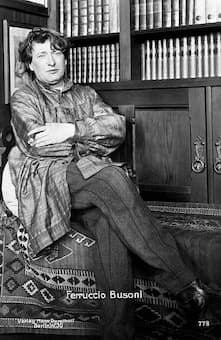
Ferruccio Busoni
Ferruccio Busoni had always been fascinated by the music of Johann Sebastian Bach, and he gradually “achieved a profound understanding of Bach’s polyphony and his expressive intentions.” Over time, Busoni translated a good many of Bach’s compositions for the piano, and the culmination of this process of understanding Bach is reflected in the Fantasia contrappuntistica. Pianist Alfred Brendel writes, “the piece is a monumental fusion of thesis and antithesis, counterpoint and fantasy, Bach and Busoni, unexpected refinement of the piano sound and baroque independence from the means of sound—you will perhaps find a new sphere of instrumental art spread out before you.” In 1909, Busoni was working on a critical edition of Bach’s The Art of Fugue, and he became fascinated with the last fugue, which Bach broke off at the entry of the fourth subject only days before his death. Busoni consulted with the composer and theorist Bernhard Ziehn, who had published various theories for a modern approach to polyphony, in which “the symmetrical treatment of melodic lines gave rise to a wealth of new harmonies.”
Ferruccio Busoni: Fantasia contrappuntistica (version for 2 pianos) “Choral-Variations” (Aldo Orvieto, piano; Aldo Ciccolini, piano)

Bach’s unfinished fugue
Berhnard Ziehn was a German-born theorist based in Chicago, and he advocated the use of transpositions and inversions to combine Bach’s original line in an absolutely symmetrical way. The original intervals are preserved at all time, “with no regard for the very un-Bach-like harmonies that resulted. This way of working, of choosing apt combinations of lines from an almost unlimited realm of possibilities, rather than searching for combinations consistent with pre-existing rules of harmony,” immediately appealed to Busoni. He certainly had a complete and exhaustive command of traditional technique, but also realized the “inadequacy of such a technique for a contemporary composer.” As a biographer writes, “Busoni was perfectly conscious of his powers: he paid homage to the past by embracing it in the gigantic sweep of his intellect and he saluted the future through his consciousness of his own moral and intellectual superiority, a consciousness that was compatible with true dignity and humility.” In his Fantasia contrappuntistica, Busoni achieves a perfect synthesis of models from the past presented in a completely modern form.
Ferruccio Busoni: Fantasia contrappuntistica (version for 2 pianos) – Fuga I (Aldo Orvieto, piano; Aldo Ciccolini, piano)
Ferruccio Busoni: Fantasia contrappuntistica (version for 2 pianos) – Fuga II (Aldo Orvieto, piano; Aldo Ciccolini, piano)
Ferruccio Busoni: Fantasia contrappuntistica (version for 2 pianos) – Fuga III (Aldo Orvieto, piano; Aldo Ciccolini, piano)

Busoni’s Fantasia Contrappuntistica
In March 1910, Busoni completed his “Grosse Fuge,” which he described as “the most corseted of his compositions.” He writes to his wife, “Every note is spot on! Today is the first of March. I had planned to finish this monster fugue in February and I succeeded, but I won’t do it again!” Bach’s original fugue is built on three themes, but at the start of the third theme the manuscript is interrupted, and within its development, a fourth theme is introduced. Busoni identifies this fourth theme as the basic motif of the whole cycle. However, Busoni is not yet satisfied, and he created a fifth theme, which acts as a conclusion. Busoni assures his wife that he had been “working in the spirit of Bach,” but in the end he does not limit himself to these five fugues, “but further develops the piece through the addition of several other movements, so as to achieve, as he affirms, “the form of a grand fantasia.”
Ferruccio Busoni: Fantasia contrappuntistica (version for 2 pianos) – Intermezzo (Aldo Orvieto, piano; Aldo Ciccolini, piano)
Ferruccio Busoni: Fantasia contrappuntistica (version for 2 pianos) – Variation 1 (Aldo Orvieto, piano; Aldo Ciccolini, piano)
Ferruccio Busoni: Fantasia contrappuntistica (version for 2 pianos) – Variation 2 (Aldo Orvieto, piano; Aldo Ciccolini, piano)
Ferruccio Busoni: Fantasia contrappuntistica (version for 2 pianos) – Variation 3 (Aldo Orvieto, piano; Aldo Ciccolini, piano)
 Busoni prefaces his “Grosse Fuge” with his own variations on the Bach chorale “Allein Gott in der Höh sei er,” composed three years earlier. Breitkopf & Härtel explain the overall form of the work at the beginning of the published score: An “Introduzione” based on Bach’s chorale (Maestoso deciso, Allegro, Andantino) leads to the first three fugues on themes by Bach; an “Intermezzo,” which then leads to the “Variazioni” on the same fugues; then a cadenza leading into the fourth fugue. Before the final “Stretta” the Chorale reappears, with ‘dolcissimo’ chords in the high register of the keyboard.”
Busoni prefaces his “Grosse Fuge” with his own variations on the Bach chorale “Allein Gott in der Höh sei er,” composed three years earlier. Breitkopf & Härtel explain the overall form of the work at the beginning of the published score: An “Introduzione” based on Bach’s chorale (Maestoso deciso, Allegro, Andantino) leads to the first three fugues on themes by Bach; an “Intermezzo,” which then leads to the “Variazioni” on the same fugues; then a cadenza leading into the fourth fugue. Before the final “Stretta” the Chorale reappears, with ‘dolcissimo’ chords in the high register of the keyboard.”
Published as the so-called “Edizione definitva” of the Fantasia contrappuntistica, the work nevertheless underwent a substantial number of revisions and versions. This includes an “Edizione minore” in 1912, basically a study edition with expanded but simplified fugal writing and different variations on the same chorale. Busoni had also panned to produce an orchestral version, but that project never materialized. Instead, on 6 August 1921, audiences were treated to a two-piano version, which integrates both sets of chorale variations and “clarifies but also abbreviates Bach’s underlying fugal arguments.” Regardless of version, Busoni created a work rooted in Bach and expanded with Lisztian textures, “that places him in a historical continuum, with a clear focus on the future.” According to critics, “it remains one of the most impressive works in the entire piano literature, a monumental undertaking that stretches the possibilities of composer, instrument, and performer to the limit.”
For more of the best in classical music, sign up to our E-Newsletter
Ferruccio Busoni: Fantasia contrappuntistica (version for 2 pianos) – Cadenza (Aldo Orvieto, piano; Aldo Ciccolini, piano)
Ferruccio Busoni: Fantasia contrappuntistica (version for 2 pianos) – Fuga IV (Aldo Orvieto, piano; Aldo Ciccolini, piano)
Ferruccio Busoni: Fantasia contrappuntistica (version for 2 pianos) – Corale (Aldo Orvieto, piano; Aldo Ciccolini, piano)
Ferruccio Busoni: Fantasia contrappuntistica (version for 2 pianos) – Stretta (Aldo Orvieto, piano; Aldo Ciccolini, piano)
